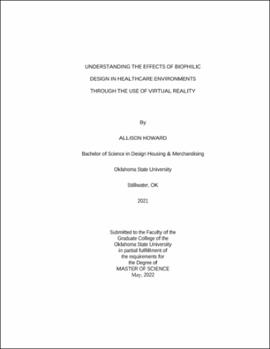| dc.contributor.advisor | Chandrasekera, Tilanka | |
| dc.contributor.author | Howard, Allison | |
| dc.date.accessioned | 2023-04-03T20:51:25Z | |
| dc.date.available | 2023-04-03T20:51:25Z | |
| dc.date.issued | 2022-05 | |
| dc.identifier.uri | https://hdl.handle.net/11244/337204 | |
| dc.description.abstract | Biophilic Design encourages the use of natural systems and processes within the design of a built environment. The biophilic hypothesis stems from the belief that humans have an innate connection with the natural world and having exposure to the natural world is essential for human wellbeing. It helps explain why a view to nature can enhance our ability to deal with stress and why plants can reduce our fatigue. Research has shown that biophilic design can impact an individual’s health and well-being in a variety of ways. Studies have identified that the majority of patients exposed to direct nature and natural patterns reported experiencing less stress and increased coping ability. Despite the emergence in popularity of Biophilic Design research, there is still little research on its overall impact on cognitive load in healthcare environments. In this study we explored how Biophilic Design effected participants’ stress levels after being exposed to an immersive image of a virtual healthcare environment. Eye-tracking together with physiological monitors that measured heart rate and skin conductance levels were used to analyze participants stress responses after randomly being selected to experience one of three virtual environments (VE). We hypothesized that exposure to the VEs with biophilic design would result in lower stress levels in patients. In order to test this, we recruited 60 participants to participate in a between-group study using VR. Participants were randomly assigned to experience one of three virtual healthcare settings and had their physiological indicators measured as they experience the space. Finally, participants were asked to fill out questionnaires regarding their stress, pleasure and arousal, and satisfaction levels. Eye-tracking paired with physiological indicators will allow researchers to measure cognitive load and fixation in participants. Researchers did not find significant differences among participants cognitive load (p = .745), but they did however find significant differences in participants moods between the three conditions. Going forward, this study could have implications for not only patients but healthcare professionals in their place of work. | |
| dc.format | application/pdf | |
| dc.language | en_US | |
| dc.rights | Copyright is held by the author who has granted the Oklahoma State University Library the non-exclusive right to share this material in its institutional repository. Contact Digital Library Services at lib-dls@okstate.edu or 405-744-9161 for the permission policy on the use, reproduction or distribution of this material. | |
| dc.title | Understanding the effects of biophilic design in healthcare environments through the use of virtual reality | |
| dc.contributor.committeeMember | Jayadas, Aditya | |
| dc.contributor.committeeMember | Clare, Gregory | |
| osu.filename | Howard_okstate_0664M_17715.pdf | |
| osu.accesstype | Open Access | |
| dc.type.genre | Thesis | |
| dc.type.material | Text | |
| dc.subject.keywords | biophilia | |
| dc.subject.keywords | design | |
| dc.subject.keywords | digital design | |
| dc.subject.keywords | healthcare | |
| dc.subject.keywords | virtual reality | |
| thesis.degree.discipline | Design, Housing, and Merchandising | |
| thesis.degree.grantor | Oklahoma State University | |
